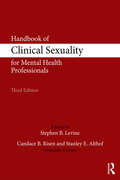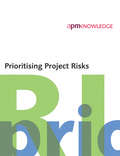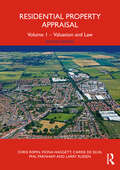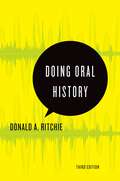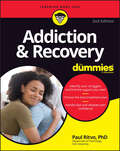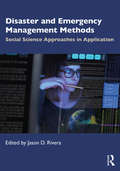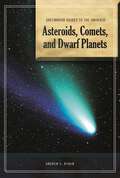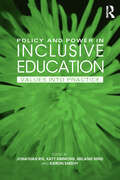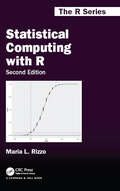- Table View
- List View
Handbook of Clinical Sexuality for Mental Health Professionals
by Candace B. Risen Stanley E. Althof Stephen B. LevineThe Handbook of Clinical Sexuality for Mental Health Professionals, 3rd Edition, builds on the authors’ authoritative first person voice on sexual matters of the previous editions. The work reflects the field's growing sophistication about sexual disorders and their therapies. The scope has been expanded to keep pace with new literature and research in the field, and eight additional chapters have been added. New topics include the politics of diagnosis, persistent genital arousal, asexuality, post orgasm illness, scientific findings concerning origin of orientation, and partnering with the pharmaceutical industry. Easily accessible, the Handbook is divided into sections that touch on fundamental knowledge and skills; treatment; men’s major sexual concerns; women’s major sexual concerns; problems common to both genders; the diversity of sexual lives; and future and trending topics. Written in a personal, supervisory style, the book will help new therapists anticipate clinical contingencies and help experienced therapists refine their thinking and teaching.
Handbook of Clinical Sexuality for Mental Health Professionals
by Candace B. Risen Stanley E. Althof Stephen B. LevineThe Handbook of Clinical Sexuality for Mental Health Professionals, 3rd Edition, builds on the authors’ authoritative first person voice on sexual matters of the previous editions. The work reflects the field's growing sophistication about sexual disorders and their therapies. The scope has been expanded to keep pace with new literature and research in the field, and eight additional chapters have been added. New topics include the politics of diagnosis, persistent genital arousal, asexuality, post orgasm illness, scientific findings concerning origin of orientation, and partnering with the pharmaceutical industry. Easily accessible, the Handbook is divided into sections that touch on fundamental knowledge and skills; treatment; men’s major sexual concerns; women’s major sexual concerns; problems common to both genders; the diversity of sexual lives; and future and trending topics. Written in a personal, supervisory style, the book will help new therapists anticipate clinical contingencies and help experienced therapists refine their thinking and teaching.
Prioritising Project Risks
by Risk Prioritisation Group of the APM Risk Management Specific Interest GroupPrioritisation is an important part of any risk management process because it focuses on what matters most. Written by the Risk Prioritisation Group of the APM Risk Management Specific Interest Group, this guide looks at how the first step towards effective risk prioritisation is an understanding of its purpose. Complementing the APM Project Risk Analysis and Management (PRAM) Guide 2nd edition, it offers a variety of risk management techniques and will help practitioners and students. Readers of this publication may also be interested in Interfacing Risk and Earned Value Management and Project Risk Analysis and Management Guide 2nd edition.
Residential Property Appraisal: Volume 1 - Valuation and Law
by Chris Rispin Fiona Haggett Carrie de Silva Phil Parnham Larry RussenResidential Property Appraisal, Volumes 1 and 2 are essential handbooks not only for students studying surveying but also for surveyors and others involved in the appraisal of residential property. Volume 1 has been updated and covers the valuation process as it relates to residential properties, particularly when valuation is undertaken for secured lending purposes. It addresses the basic skills required, the risks posed in a valuation, the key drivers of value, emerging issues that impact valuation and the key legal and RICS Regulatory considerations that a valuer needs to understand. Volume 2 of the book goes on to address the inspection and survey of residential properties, covering new technology, modern methods of construction, problem plants and pests, damp in new builds, and modern building services. New challenges for the surveyor to consider include the health and well-being of building occupants, the Party Wall etc. Act 1996 and schedules of condition, energy and building performance, and owner-occupied and tenanted properties. An essential book for students studying to enter the residential survey and valuation profession and for existing practitioners who wish to improve their knowledge of industry practices.
Residential Property Appraisal: Volume 1 - Valuation and Law
by Chris Rispin Fiona Haggett Carrie de Silva Phil Parnham Larry RussenResidential Property Appraisal, Volumes 1 and 2 are essential handbooks not only for students studying surveying but also for surveyors and others involved in the appraisal of residential property. Volume 1 has been updated and covers the valuation process as it relates to residential properties, particularly when valuation is undertaken for secured lending purposes. It addresses the basic skills required, the risks posed in a valuation, the key drivers of value, emerging issues that impact valuation and the key legal and RICS Regulatory considerations that a valuer needs to understand. Volume 2 of the book goes on to address the inspection and survey of residential properties, covering new technology, modern methods of construction, problem plants and pests, damp in new builds, and modern building services. New challenges for the surveyor to consider include the health and well-being of building occupants, the Party Wall etc. Act 1996 and schedules of condition, energy and building performance, and owner-occupied and tenanted properties. An essential book for students studying to enter the residential survey and valuation profession and for existing practitioners who wish to improve their knowledge of industry practices.
Doing Oral History (Oxford Oral History Series)
by Donald A. RitchieDoing Oral History is considered the premier guidebook to oral history, used by professional oral historians, public historians, archivists, and genealogists as a core text in college courses and throughout the public history community. Over the past decades, the development of digital audio and video recording technology has continued to alter the practice of oral history, making it even easier to produce quality recordings and to disseminate them on the Internet. This basic manual offers detailed advice on setting up an oral history project, conducting interviews, making video recordings, preserving oral history collections in archives and libraries, and teaching and presenting oral history. Using the existing Q&A format, the third edition asks new questions and augments previous answers with new material, particularly in these areas: 1. Technology: As before, the book avoids recommending specific equipment, but weighs the merits of the types of technology available for audio and video recording, transcription, preservation, and dissemination. Information about web sites is expanded, and more discussion is provided about how other oral history projects have posted their interviews online. 2. Teaching: The new edition addresses the use of oral history in online teaching. It also expands the discussion of Institutional Review Boards (IRBs) with the latest information about compliance issues. 3. Presentation: Once interviews have been conducted, there are many opportunities for creative presentation. There is much new material available on innovative forms of presentation developed over the last decade, including interpretive dance and other public performances. 4. Legal considerations: The recent Boston College case, in which the courts have ruled that Irish police should have access to sealed oral history transcripts, has re-focused attention on the problems of protecting donor restrictions. The new edition offers case studies from the past decade. 5. Theory and Memory: As a beginner's manual, Doing Oral History has not dealt extensively with theoretical issues, on the grounds that these emerge best from practice. But the third edition includes the latest thinking about memory and provides a sample of some of the theoretical issues surrounding oral sources. It will include examples of increased studies into catastrophe and trauma, and the special considerations these have generated for interviewers. 6. Internationalism: Perhaps the biggest development in the past decade has been the spreading of oral history around the world, facilitated in part by the International Oral History Association. New oral history projects have developed in areas that have undergone social and political upheavals, where the traditional archives reflect the old regimes, particularly in Eastern Europe, the Middle East, Asia, Africa, and Latin America. The third edition includes many more references to non-U.S. projects that will still be relevant to an American audience. These changes make the third edition of Doing Oral History an even more useful tool for beginners, teachers, archivists, and all those oral history managers who have inherited older collections that must be converted to the latest technology.
Doing Oral History (Oxford Oral History Series)
by Donald A. RitchieDoing Oral History is considered the premier guidebook to oral history, used by professional oral historians, public historians, archivists, and genealogists as a core text in college courses and throughout the public history community. Over the past decades, the development of digital audio and video recording technology has continued to alter the practice of oral history, making it even easier to produce quality recordings and to disseminate them on the Internet. This basic manual offers detailed advice on setting up an oral history project, conducting interviews, making video recordings, preserving oral history collections in archives and libraries, and teaching and presenting oral history. Using the existing Q&A format, the third edition asks new questions and augments previous answers with new material, particularly in these areas: 1. Technology: As before, the book avoids recommending specific equipment, but weighs the merits of the types of technology available for audio and video recording, transcription, preservation, and dissemination. Information about web sites is expanded, and more discussion is provided about how other oral history projects have posted their interviews online. 2. Teaching: The new edition addresses the use of oral history in online teaching. It also expands the discussion of Institutional Review Boards (IRBs) with the latest information about compliance issues. 3. Presentation: Once interviews have been conducted, there are many opportunities for creative presentation. There is much new material available on innovative forms of presentation developed over the last decade, including interpretive dance and other public performances. 4. Legal considerations: The recent Boston College case, in which the courts have ruled that Irish police should have access to sealed oral history transcripts, has re-focused attention on the problems of protecting donor restrictions. The new edition offers case studies from the past decade. 5. Theory and Memory: As a beginner's manual, Doing Oral History has not dealt extensively with theoretical issues, on the grounds that these emerge best from practice. But the third edition includes the latest thinking about memory and provides a sample of some of the theoretical issues surrounding oral sources. It will include examples of increased studies into catastrophe and trauma, and the special considerations these have generated for interviewers. 6. Internationalism: Perhaps the biggest development in the past decade has been the spreading of oral history around the world, facilitated in part by the International Oral History Association. New oral history projects have developed in areas that have undergone social and political upheavals, where the traditional archives reflect the old regimes, particularly in Eastern Europe, the Middle East, Asia, Africa, and Latin America. The third edition includes many more references to non-U.S. projects that will still be relevant to an American audience. These changes make the third edition of Doing Oral History an even more useful tool for beginners, teachers, archivists, and all those oral history managers who have inherited older collections that must be converted to the latest technology.
Kant and Post-Tractarian Wittgenstein: Transcendentalism, Idealism, Illusion
by Bernhard RitterThis book suggests that to know how Wittgenstein’s post-Tractarian philosophy could have developed from the work of Kant is to know how they relate to each other. The development from the latter to the former is invoked heuristically as a means of interpretation, rather than a historical process or direct influence of Kant on Wittgenstein. Ritter provides a detailed treatment of transcendentalism, idealism, and the concept of illusion in Kant’s and Wittgenstein’s criticism of metaphysics. Notably, it is through the conceptions of transcendentalism and idealism that Wittgenstein’s philosophy can be viewed as a transformation of Kantianism. This transformation involves a deflationary conception of transcendental idealism along with the abandonment of both the idea that there can be a priori 'conditions of possibility' logically detachable from what they condition, and the appeal to an original ‘constitution’ of experience. The closeness of Kant and post-Tractarian Wittgenstein does not exist between their arguments or the views they upheld, but rather in their affiliation against forms of transcendental realism and empirical idealism. Ritter skilfully challenges several dominant views on the relationship of Kant and Wittgenstein, especially concerning the cogency of Wittgenstein-inspired criticism focusing on the role of language in the first Critique, and Kant's alleged commitment to a representationalist conception of empirical intuition.
Addiction & Recovery For Dummies
by Paul RitvoNo matter what your road to recovery looks like, Dummies is on your side Addiction and Recovery For Dummies gives you the tools you need to identify and face addiction in yourself or a loved one, while working towards a healthy and realistic approach to recovery. This book offers a compassionate, unbiased, and non-judgmental guide to evaluating and overcoming addiction. You’ll learn to identify the range of addiction levels, the various types (including substance and non-substance), and the possible causes of addiction. An expert author guides you through the range of addiction treatment philosophies and approaches, including twelve-step programs, other in- and outpatient programs, and teen treatments. We’ll also look at common recovery roadblocks, so you’re prepared to overcome whatever hurdles your recovery process brings. Medications, therapeutic communities, self-help groups, long-term recovery strategies—it’s all in here. Learn the signs of addiction and identify the most appropriate treatments Gain advice on offering help to friends or family members struggling with addiction Discover available recovery supports, including groups and medications Understand the media and cultural factors that encourage addiction, and how to avoid themUpdated with the latest treatment options, Addiction & Recovery For Dummies is a valuable resource for those on a recovery journey, and a support guide for the 45 million people who are directly impacted by addiction.
Addiction & Recovery For Dummies
by Paul RitvoNo matter what your road to recovery looks like, Dummies is on your side Addiction and Recovery For Dummies gives you the tools you need to identify and face addiction in yourself or a loved one, while working towards a healthy and realistic approach to recovery. This book offers a compassionate, unbiased, and non-judgmental guide to evaluating and overcoming addiction. You’ll learn to identify the range of addiction levels, the various types (including substance and non-substance), and the possible causes of addiction. An expert author guides you through the range of addiction treatment philosophies and approaches, including twelve-step programs, other in- and outpatient programs, and teen treatments. We’ll also look at common recovery roadblocks, so you’re prepared to overcome whatever hurdles your recovery process brings. Medications, therapeutic communities, self-help groups, long-term recovery strategies—it’s all in here. Learn the signs of addiction and identify the most appropriate treatments Gain advice on offering help to friends or family members struggling with addiction Discover available recovery supports, including groups and medications Understand the media and cultural factors that encourage addiction, and how to avoid themUpdated with the latest treatment options, Addiction & Recovery For Dummies is a valuable resource for those on a recovery journey, and a support guide for the 45 million people who are directly impacted by addiction.
Disaster and Emergency Management Methods: Social Science Approaches in Application
by Jason D. RiveraFind the answers to disaster and emergency management research questions with Disaster and Emergency Management Methods. Written to engage students and to provide a flexible foundation for instructors and practitioners, this interdisciplinary textbook provides a holistic understanding of disaster and emergency management research methods used in the field. The disaster and emergency management contexts have a host of challenges that affect the research process that subsequently shape methodological approaches, data quality, analysis and inferences. In this book, readers are presented with the considerations that must be made before engaging in the research process, in addition to a variety of qualitative and quantitative methodological approaches that are currently being used in the discipline. Current, relevant, and fascinating real-world applications provide a window into how each approach is being applied in the field. Disaster and Emergency Management Methods serves as an effective way to empower readers to approach their own study of disaster and emergency management research methods with confidence.
Disaster and Emergency Management Methods: Social Science Approaches in Application
by Jason D. RiveraFind the answers to disaster and emergency management research questions with Disaster and Emergency Management Methods. Written to engage students and to provide a flexible foundation for instructors and practitioners, this interdisciplinary textbook provides a holistic understanding of disaster and emergency management research methods used in the field. The disaster and emergency management contexts have a host of challenges that affect the research process that subsequently shape methodological approaches, data quality, analysis and inferences. In this book, readers are presented with the considerations that must be made before engaging in the research process, in addition to a variety of qualitative and quantitative methodological approaches that are currently being used in the discipline. Current, relevant, and fascinating real-world applications provide a window into how each approach is being applied in the field. Disaster and Emergency Management Methods serves as an effective way to empower readers to approach their own study of disaster and emergency management research methods with confidence.
The Scope and Structure of Civil Codes (Ius Gentium: Comparative Perspectives on Law and Justice #32)
by Julio César RiveraThis detailed analysis of the content and configuration of civil codes in diverse jurisdictions also examines their relationship with some branches of private law as: family law, commercial law, consumer law and private international law. It analyzes the codification, decodification and recodification processes illuminating the dialogue between current codes – and private law legislation in general – with Constitutions and International Conventions.The commentary elucidates the changing requirements of civil law as it shifted from an early protection of patrimony to a support for commercial and contractual law. It also explains the varying trajectories of civil law, which in some jurisdictions was merged with religious legal tenets in its codification of familial relations, while in others it was fused with commercial law or, indeed, codified from scratch as a discrete legal corpus. Elsewhere, the volume provides material on differing approaches to consumer law, where relevant legislation may be scattered across numerous statutes, and also on private international law, a topic of increasing relevance in a world where business corporations have interests in multiple jurisdictions (and often play one off against another).The volume features invited contributions from leading scholars in the field of private law brought together for an in depth analysis of the current regulatory attitude in this field of the law in jurisdictions with diverse legal systems and traditions. In current times we are witnessing the adoption of diverging regulatory solutions. Through the analysis of the past and present of private law regulation, the volume unveils the underlying trends and relevance of the codification method across the world.
Guide to the Universe: Asteroids, Comets, and Dwarf Planets (Greenwood Guides to the Universe)
by Andrew S. RivkinGeared toward students, this guide provides an overview of the small bodies that orbit the sun.This volume in the Greenwood Guides to the Universe series covers asteroids, comets, and dwarf planets—those small bodies that revolve the Sun—and provides readers with the most up-to-date understanding of the current state of scientific knowledge about them. Scientifically sound, but written with the student in mind, Asteroids, Comets, and Dwarf Planets is an excellent first step for researching the exciting scientific discoveries of the smallest celestial bodies in the solar system.The book will introduce students to all of the areas of research surrounding the subject, answering many intriguing questions. It defines a dwarf planet and explains why Pluto is one. It looks at how such small bodies form, what they are made of, and what kind of atmospheres might they have. And it asks—and answers—whether asteroids, comets, and dwarf planets present a hazard to the Earth or to spacecraft.
Policy and Power in Inclusive Education: Values into practice
by Jonathan Rix Katy Simmons Melanie Nind Kieron SheehyThe movement towards inclusive education is undoubtedly an international phenomenon, and it has resulted in the development of policy initiatives impacting on schools in all nations. This informative, wide-ranging text brings together key illustrative material from an international field. It adopts a critical perspective on policy issues, but goes beyond this by making explicit the assumptions that drive policy development. Readers will be encouraged to develop their own framework, allowing them to conduct policy analysis and evaluation within their own educational context.Students and researchers interested in how principles of inclusive education are being translated into educational practices around the world will find this book an enlightening read.
Statistical Computing with R, Second Edition (Chapman & Hall/CRC The R Series)
by Maria L. RizzoComputational statistics and statistical computing are two areas that employ computational, graphical, and numerical approaches to solve statistical problems, making the versatile R language an ideal computing environment for these fields. This second edition continues to encompass the traditional core material of computational statistics, with an
Statistical Computing with R, Second Edition (Chapman & Hall/CRC The R Series)
by Maria L. RizzoComputational statistics and statistical computing are two areas that employ computational, graphical, and numerical approaches to solve statistical problems, making the versatile R language an ideal computing environment for these fields. This second edition continues to encompass the traditional core material of computational statistics, with an
DOT symbols: bus, ground transportation (Large Print)
by RnibOn this page there are two US Department of Transport (DOT) pictograms used for signage and travel information: a bus pictogram and a ground transportation pictogram. There is a locator dot shown, which will be at the top left of the page when the image is the correct way up. The bus pictogram is at the top centre of the page. It shows a stylised image of a single-decker bus seen from the front. At the top of the image are the buses roof and the destination sign. Down the page is the front widow, two circles representing the front lights and further down, the front wheels. At the bottom centre of the page is the ground transportation pictogram. It consists of an image of a taxi seen from the front on the left and a smaller image of a bus as described above, to the right. At the top of the taxi image is its taxi sign and below this are the front window, two headlights and two front wheels.
DOT symbols: bus, ground transportation (UEB Uncontracted)
by RnibOn this page there are two US Department of Transport (DOT) pictograms used for signage and travel information: a bus pictogram and a ground transportation pictogram. There is a locator dot shown, which will be at the top left of the page when the image is the correct way up. The bus pictogram is at the top centre of the page. It shows a stylised image of a single-decker bus seen from the front. At the top of the image are the buses roof and the destination sign. Down the page is the front widow, two circles representing the front lights and further down, the front wheels. At the bottom centre of the page is the ground transportation pictogram. It consists of an image of a taxi seen from the front on the left and a smaller image of a bus as described above, to the right. At the top of the taxi image is its taxi sign and below this are the front window, two headlights and two front wheels.
DOT symbols: car rental, restaurant (Large Print)
by RnibOn this page there are two US Department of Transport (DOT) pictograms used for signage and travel information: a car rental pictogram and a restaurant pictogram. There is a locator dot shown, which will be at the top left of the page when the image is the correct way up. The car rental pictogram is at the top left of the page. It comprises of a silhouette image of a door key with its blade to the right at the top. Down the page is a stylised image of a car seen from the front. At the top of the car is the windscreen and down the page are the two headlights and two wheels. The restaurant symbol is at the bottom right of the page. It shows a stylised image of a knife and fork. They are seen from above with the forks prongs and the knifes blade to the top of the image. The sharp cutting edge of the knife is to the left.
DOT symbols: bus, ground transportation (UEB Contracted)
by RnibOn this page there are two US Department of Transport (DOT) pictograms used for signage and travel information: a bus pictogram and a ground transportation pictogram. There is a locator dot shown, which will be at the top left of the page when the image is the correct way up. The bus pictogram is at the top centre of the page. It shows a stylised image of a single-decker bus seen from the front. At the top of the image are the buses roof and the destination sign. Down the page is the front widow, two circles representing the front lights and further down, the front wheels. At the bottom centre of the page is the ground transportation pictogram. It consists of an image of a taxi seen from the front on the left and a smaller image of a bus as described above, to the right. At the top of the taxi image is its taxi sign and below this are the front window, two headlights and two front wheels.
DOT symbols: car rental, restaurant (UEB Contracted)
by RnibOn this page there are two US Department of Transport (DOT) pictograms used for signage and travel information: a car rental pictogram and a restaurant pictogram. There is a locator dot shown, which will be at the top left of the page when the image is the correct way up. The car rental pictogram is at the top left of the page. It comprises of a silhouette image of a door key with its blade to the right at the top. Down the page is a stylised image of a car seen from the front. At the top of the car is the windscreen and down the page are the two headlights and two wheels. The restaurant symbol is at the bottom right of the page. It shows a stylised image of a knife and fork. They are seen from above with the forks prongs and the knifes blade to the top of the image. The sharp cutting edge of the knife is to the left.
DOT symbols: car rental, restaurant (UEB Uncontracted)
by RnibOn this page there are two US Department of Transport (DOT) pictograms used for signage and travel information: a car rental pictogram and a restaurant pictogram. There is a locator dot shown, which will be at the top left of the page when the image is the correct way up. The car rental pictogram is at the top left of the page. It comprises of a silhouette image of a door key with its blade to the right at the top. Down the page is a stylised image of a car seen from the front. At the top of the car is the windscreen and down the page are the two headlights and two wheels. The restaurant symbol is at the bottom right of the page. It shows a stylised image of a knife and fork. They are seen from above with the forks prongs and the knifes blade to the top of the image. The sharp cutting edge of the knife is to the left.
DOT symbols: coat check, baggage lockers (UEB Contracted)
by RnibOn this page there are two US Department of Transport (DOT) pictograms used for signage and travel information: a coat check symbol and a baggage lockers pictogram. There is a locator dot shown, which will be at the top left of the page when the image is the correct way up. The coat check symbol is at the top of the page. It is a stylised image of a coat hanger with its hook at the top of the image. The baggage lockers pictogram is at the bottom of the page. At the top of the pictogram is a key with its blade to the right and below this is a rectangle representing a locker. This has a stylised image of a suitcase inside it.
DOT symbols: coat check, baggage lockers (UEB Uncontracted)
by RnibOn this page there are two US Department of Transport (DOT) pictograms used for signage and travel information: a coat check symbol and a baggage lockers pictogram. There is a locator dot shown, which will be at the top left of the page when the image is the correct way up. The coat check symbol is at the top of the page. It is a stylised image of a coat hanger with its hook at the top of the image. The baggage lockers pictogram is at the bottom of the page. At the top of the pictogram is a key with its blade to the right and below this is a rectangle representing a locker. This has a stylised image of a suitcase inside it.
